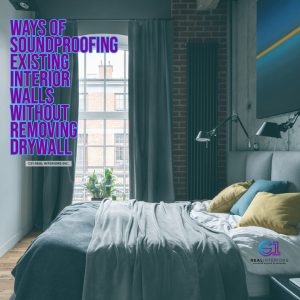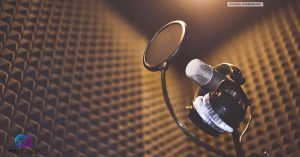Ways of Soundproofing Existing Interior Walls Without Removing Drywall

drywall soundproofing in portland Oregon
Ways of soundproofing existing interior walls without removing drywall.
These are the most effective ways to soundproof existing walls from my list.
- Add Insulation
- Install a Second Layer of Drywall With Green Glue
- Use Resilient Clips & Channels
- Add Mass Loaded Vinyl
- Build a New Wall in Front of Existing
- Install Acoustic Foam Panels
Some of these options are more effective than others. While a few of them may be pretty simple to implement, some will be much more extensive and require more work. Let’s discuss what each one entails and how effective it will be at helping to soundproof your interior walls.

Soundproofing Interior Walls Without Removing Drywall
1. Add Blown-In Insulation
Blown insulation is loose, low-density cellulose insulation that is made mostly from recycled newsprint. With an STC rating of 44, it can be very effective at helping to soundproof both interior and exterior walls. It can be added into walls after construction, a task that is very difficult with other types of insulation.
Adding blow-in insulation into your existing walls will increase their sound absorption abilities. The cellulose traps little pockets of air, which then trap sound waves and drain their energy, nullifying the noise before it reaches the other side.
Because it is blown-in, unlike other forms of insulation, the cellulose insulation can fill all of the little nooks, crannies, and holes. Otherwise, they would be points of entry for outside soundwaves to make their way in.
Cellulose blow-in insulation provides several advantages. It is a very cost-effective way to help soundproof your interior walls. Also, it can be installed by many homeowners by renting the machine from a local home improvement store such as The Home Depot.
Finally, cellulose is a very “green” insulation, being made up of more recycled material than any other type of insulation that’s commercially available.
Blow-in insulation is available in a few varieties. It comes in loose, wet, and dense pack options. For more information about blow-in insulation, read my article about soundproofing insulation.
Install Another Layer of Drywall With Green Glue
You screw an additional piece of sheetrock on top of your existing wall. Thicker drywall will block more sound, so go with ⅝” if possible.
As we mentioned, though, adding mass by itself is not going to produce the sound reduction results that you’re looking for. To achieve more drastic soundproofing, we’re going to add a layer of Green Glue noiseproofing compound in between our drywall layers.
Green Glue is an incredibly effective and inexpensive way to soundproof your interior walls. It’s an easily applied liquid that comes either in a tube or a bucket. As a soundproofing compound, it is effective at reducing all types of noise.
If you want to kill vibrations, Green Glue creates a dampening layer between your sheetrock that absorbs and dissipates vibrations, effectively stopping incoming noise.
Apply the Green Glue to the back of your new drywall, then screw it to your existing wall. You can then finish the drywall as you normally would.
Second Layer of Drywall Decoupled With Resilient Clips & Channels
By decoupling our new drywall layer from the original wall using resilient clips and channels, we can eliminate most impact noises, and even seriously reduce many of the airborne sounds as well.
The resilient clips feature rubber backs that will help decouple them from the wall they’re attached to. You will mount the clips to your existing wall by drilling screws through your existing drywall and into the studs behind.
The resilient channels will be mounted horizontally and fastened to the clips. Your second layer of drywall will then screw directly into the channels.
Unfortunately, when installed on existing drywall, resilient clips and channels do lose a lot of their effectiveness. However, this can be remedied by adding some R-6 insulation once the channels are installed and before adding the drywall. The channels will hold the insulation in place for easy installation of the drywall.
Add Mass Loaded Vinyl
When installed between two layers of drywall, MLV can stop the vibrations between them, dampening the entire wall. This will help to absorb and dissipate external sound sources.
MLV can be nailed directly to your existing drywall. Overlap the seams of each piece by 2” and cover with vinyl tape.
Carefully, cut tightly around any outlets and switches. The MLV will block these open-air spaces where sound can penetrate, which will eliminate the need for outlet insulation gaskets.
Once mass loaded vinyl is installed to your existing drywall, it is time to add your additional drywall layer. You can use regular or drywall, or for maximum soundproofing, you can use the QuietRock acoustic sheetrock we mentioned in method 4. Just screw your new drywall layer into the studs through the original layer.
If you want to truly negate all sound coming in through your existing walls, you can also install resilient clips and channels. These would be mounted on top of your MLV. You would then hang QuietRock on the resilient channel and be certain to seal up all the edges with acoustic caulk.
Build a New Wall in Front of Existing
Your second wall will be attached to the floor and the ceiling instead of the original wall. You can start by framing out your new wall, then adding insulation for sound absorption.
Next, you will install MLV over the frame of the wall by nailing it to the studs. Make sure to get full coverage from floor to ceiling, but it’s important that the MLV does not come into contact with either.
Once your MLV is installed, you can fasten the resilient clips to the studs with screws. Then you can attach the resilient channels to the clips.
After you’ve installed your resilient clips and channel, you can install ⅝” drywall. Drywall is preferable to QuietRock here because the soundproofing effect of the QuietRock with the resilient channel provides negligible results over just resilient channels or QuietRock alone.
Once the drywall installation is complete, make sure to use acoustical caulk to seal all of the edges and corners. Finally, add the outlet and switch insulation gaskets to ensure there are no points of entry for rogue soundwaves.
For ultimate effectiveness and to control the acoustics within the room, you can hang acoustic fabric panels from method 8 on this list on your new wall.
For more information on building a second wall, please see our article How to Build a Soundproof Room-Within-a-Room.
Hang Acoustic Fabric Panels
Acoustic fabric panels are a great way to reduce the external noise coming into your room, while also being aesthetically pleasing. They are offered in a variety of colors to match the current color scheme of your decor.
As a bonus, they also vastly improve the acoustics inside your room by absorbing reverberations and echos. This makes movies, music, and even conversations sound much better. These are used in professional applications for this effect.
With an NRC rating of 1 out of 1, panels such as these from ATS offer superior sound absorption. They can be easily hung in many configurations and will help to prevent a lot of airborne noise from reaching your home’s interior.
This is one of the simplest methods of soundproofing your existing walls, and it won’t leave lasting damage in case you have to move out again.
Also make sure you check out my post about DIY acoustic panels.






